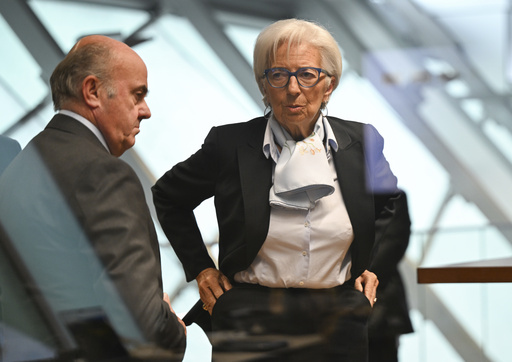FRANKFURT, Germany (AP) — The European Central Bank signalled Thursday it could cut interest rates at its next meeting in June, a big step as the rich world’s central banks, including the U.S. Federal Reserve, wrestle with how soon declining inflation will let them lower credit costs for business and consumers.
The bank left its key rate benchmarks unchanged at a record high of 4%, but bank President Christine Lagarde said a rate cut was now on the table.
If incoming data confirm inflation’s decline, “it would be appropriate to reduce the current level of monetary policy restriction,” she said at her post-decision news conference.
The policy meeting at the bank’s skyscraper headquarters in Frankfurt was widely regarded as a prelude to the June 6 meeting, after Lagarde had dropped a broad hint by saying that the bank would have more information on the path of inflation at that meeting.
Thursday’s stance “officially opens the door to a June rate cut,” said Carsten Brzeski, chief of global macro at ING bank. “This is the first time the ECB has talked about rate cuts in its official policy announcement.”
The decision comes as the rich world’s central banks are tilting toward undoing some of the sharp hikes to interest rates that were imposed with the goal of getting inflation under control. The Swiss National Bank was the first major central bank to cut rates in the current cycle on March 21. The big exception is Japan, which raised rates for the first time in 17 years on March 19.
It’s a policy shift closely watched by stock investors. Markets soared in recent months on expectations of lower rates by this summer. Broad stock market indexes fell immediately in the U.S. on Wednesday and bond prices rose after a hotter than expected inflation reading of 3.5% for March raised fears that the Fed may wait longer than previously thought to lower its benchmark interest rate.
Lagarde said the ECB’s actions on rates were based on Europe’s inflation data, and only took U.S. inflation into account as part of the bigger global picture including China, Japan and emerging markets. “We have to determine monetary policy decisions on the basis of the data that are produced by the euro area, on the basis of the global environment,” she said.
The drivers of inflation in the U.S. are different, she said, and “the two economies are not the same.”
Inflation in the 20 European Union member countries that use the euro currency, and where the ECB sets interest rate policy, has fallen to 2.4% in March, down from a peak of 10.6% in October 2023.
Economists say U.S. inflation was driven by large-scale government spending, while Europe’s price spike came from an outside shock: Russia cutting off most supplies of cheap natural gas after its invasion of Ukraine. Energy prices have now fallen to pre-war levels, and inflation levels have gradually eased as a result.
Higher rates help squelch inflation by raising the cost of borrowing to buy things, which can cool demand for goods — but they can also slow growth if overdone or maintained for too long. And growth in Europe has been anemic to say the least. The eurozone economy didn’t grow at all in the last three months of last year and the outlook for the figures from the quarter just ended isn’t much better.
The central bank’s benchmarks guide the costs of borrowing for banks, and through that influence rates throughout the economy, from business credit lines to mortgages and credit cards to government bonds.
Rate cuts can boost stocks because they suggest the central bank sees a strong economy ahead that will boost corporate profits, and because lower interest rates make stocks relatively more attractive compared with interest-bearing holdings such as bonds or CDs.



